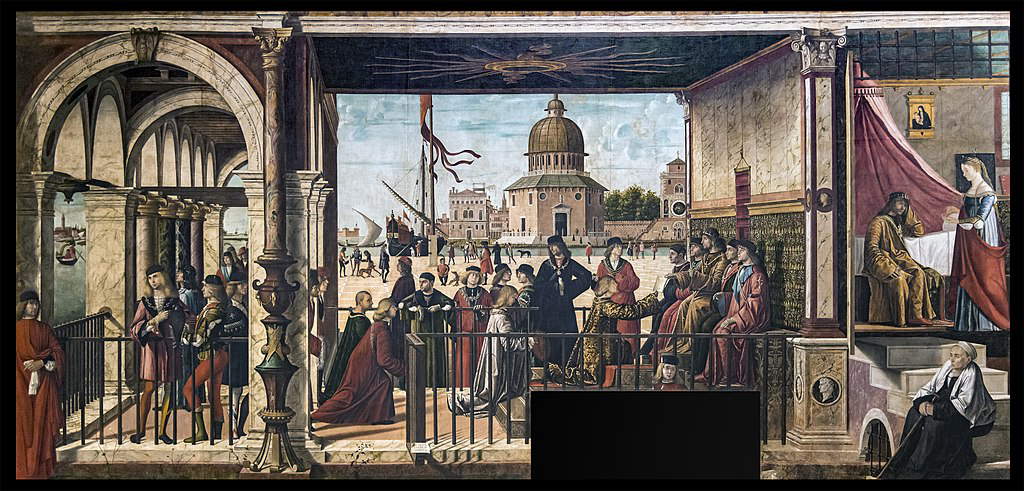Venice, Carpaccio's stories of St. Ursula visible again at Gallerie dell'Accademia
Starting next June 8, the Stories of St. Ursula, a masterpiece by Vittore Carpaccio (Venice, 1455/1465 - Venice?, 1525/1526), will be back on view for the public at the Gallerie dell’Accademia in Venice, the museum where the cycle is preserved. Having undergone a restoration carried out thanks to the contribution of Save Venice and preceded by a preparatory phase of study and diagnostic analysis conducted by the Istituto Superiore per la Conservazione e il Restauro in Rome and the Gallerie’s Scientific Laboratory starting in 2010, the nine canvases that make up the cycle are now re-presented with improved and above all uniform legibility.
The Stories of St. Ursula date to a period between 1490 and 1495 and were intended to decorate the walls of the Scuola di Sant’Orsola, which counted among its members many Venetian patricians, including the Loredans, whose arms stand out in the telero with the episode of the Martyrdom of St. Ursula, and young men associated with the Compagnia della Calza, depicted with their emblems in the scenes of theArrival of the Ambassadors and theMeeting of the Engaged. One and the other probably played a significant role in the commission of the cycle.
The works reached the Accademia Galleries in the early 19th century, following the enactment of laws suppressing religious orders and confraternities. Their unified arrangement, however, did not occur until 1895, by director Giulio Cantalamessa, in an octagonal room located in today’s Room XXIII. A new arrangement, with dossals and wooden seats to recall the Renaissance layout of the Scuola, was proposed in the 1920s by superintendent Gino Fogolari, in the room currently occupied by the cycle. The arrangement of the canvases changed radically in 1946-47: at that time a new arrangement, devised by Carlo Scarpa and Vittorio Moschini, cancelled the previous re-setting in style and put the works back at the center of the vision. This arrangement has been maintained, practically unchanged, until the present day and is re-proposed today at the conclusion of the works, except for one significant variation: the scene of the Dream of Saint Ursula has in fact been put before the one with The Meeting in Rome with Pope Ciriaco. The order of the cycle recalled by the ancient sources and adopted in the previous Cantalamessa and Fogolari arrangements and mutated in Moschini’s is thus restored.
The works, in fact, were in an uneven state of conservation, covered with altered varnishes and locally fragmentary pictorial overpaintings. Thus, the poor aesthetic perception of the individual works was combined with a diversified appearance that strongly conditioned the reading of the cycle as a unified whole. The main causes lay in the uneven conservation conditions and the ancient restorative events to which the works had been subjected. In fact, the numerous interventions began with Vittore Carpaccio still alive and ended, in 1982-84, with the restoration by Ottorino Nonfarmale. Of the latter intervention, the linings and wooden expansion frames, which are still efficient, have been preserved.
The first conservation intervention, in 2013, was conducted on the episode of theArrival in Cologne, and was carried out by the ISCR, with Francesca Capanna, Anna Maria Marcone, Paolo Scarpitti and Carla Zaccheo, under the direction of Matteo Ceriana, Maria Chiara Maida and Daila Radeglia. The closure of the room in which the Stories of St. Ursula are kept, in August 2016, initiated the work on the rest of the cycle. The restoration of theApotheosis of St. Ursula was conducted under the direction of Francesca Capanna, Dora Catalano and Carla Zaccheo, of the firm CBArt, while the intervention on the remaining seven canvases was carried out under the direction of Giulio Manieri Elia and Alfeo Michieletto and the coordination of scientific investigations by Ornella Salvadori, by the temporary grouping of the firms C.B.C. of Rome and Egidio Arlango of Vicenza, with Paolo Cremonesi advising on the definition of the cleaning protocol.
The restoration site, by a significant choice of the management, was kept visible to scholars and museum-goers through special guided tours.
Pictured: the scene of theArrival of the Ambassadors from Vittore Carpaccio’s Stories of St. Ursula cycle.
 |
| Venice, Carpaccio's stories of St. Ursula visible again at Gallerie dell'Accademia |
Warning: the translation into English of the original Italian article was created using automatic tools. We undertake to review all articles, but we do not guarantee the total absence of inaccuracies in the translation due to the program. You can find the original by clicking on the ITA button. If you find any mistake,please contact us.



























